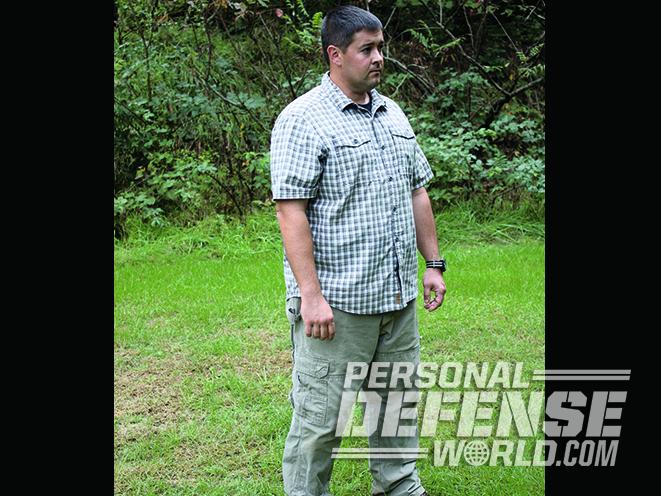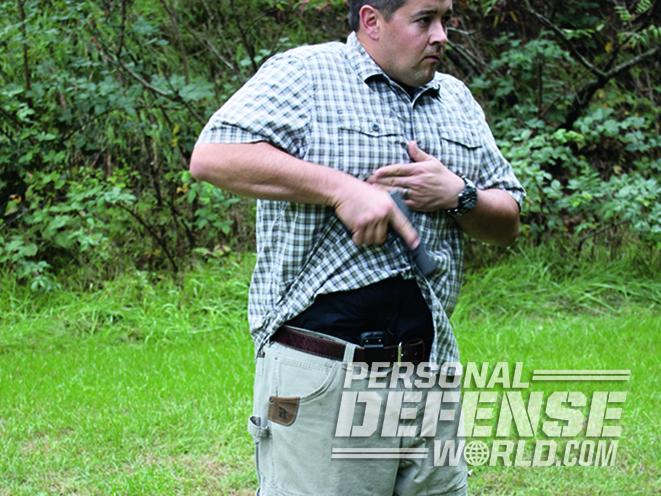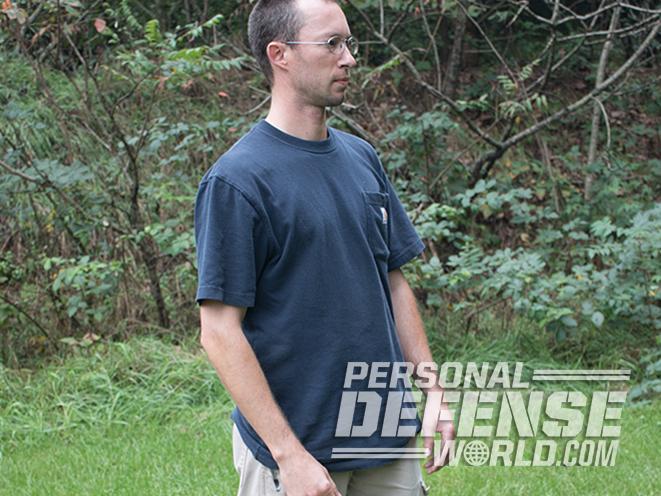“Appendix carry” is trending upward in popularity among off-duty police officers and armed citizens alike. It’s certainly not new, but it is very much in vogue. Appendix carry means the handgun is situated somewhere between your navel and strong-side hip in front of your abdomen. For concealment purposes, you normally carry the holster inside your waistband. Hence the term “appendix inside the waistband” (AIWB) carry.
This is not to say that everyone in the world of guns is on board with the concept. There are many instructors who don’t care for it at all and aren’t shy about saying so. Let’s look at the pros and cons.
Where to Appendix Carry
The most common technique is to carry your gun in a holster on or just behind your hip, either inside or outside the waistband (OWB). This has advantages that go far beyond conventionality. Many handgun sports—IDPA and PPC, to name two—forbid carry forward of the hip for safety reasons. The same is true of some police academies and some shooting schools. And by carrying your gun in same place on your own time, all of the repetitions on the range carry over to a self-defense draw if one becomes necessary.
Advertisement — Continue Reading Below
- RELATED STORY: 30 Cutting-Edge Holsters to Secure Your Firearm
Strong-side draws can be quite fast. The gun arm simply has to come straight back, preferably with the elbow pointing to the rear for efficiency, to reach the gun while in a standing position. Unless you’re very wide in the waist area, your concealing garment probably drapes down from your shoulders and lats, concealing the gun without a bulge in the natural hollow below and behind the rib cage.
Because our hands are more likely to be in front of our torsos instead of down by our sides most in the time in everyday life, AIWB fans make the point that “in real life,” our hands may be closer to the gun if the weapon is also at the front of the body. Practitioners of fighting combined with shooting, such as AIWB fan Craig “Southnarc” Douglas, note that in close-quarter grappling, it may often be easier for the defender to reach a gun placed along the front midline than behind the hip. They also correctly note that an attempt by a criminal to snatch your gun out of its holster from behind will probably be harder if your sidearm is in the appendix position.
Safety Issues
The safety element is the most controversial part of the AIWB debate. Here is an after-action report posted online by an instructor after a self-inflicted gunshot wound involving an AIWB holster at the Burro Canyon Shooting Park in California:
Advertisement — Continue Reading Below
- • On Sunday 7 June 2015 at ap-proximately 2:30 p.m. I had just givena brief on the Tueller Drill, my RSOEnrique added to the lesson when I heard the sound of a single gunshot and then the distinct sound of a man in pain from the adjacent range to our own. I quickly walked over past the edge of the berm blocking my view and saw a man checking his abdominal area. Then, I asked what happened and he responded that he had shot himself. At that point I ran over to the patient and the following occurred.
- Patient was a 30ish-year-old male. Had the patient lay down to better triage his wounds. Had the patient’s legs elevated by another member of party.
- The patient’s shirt was raised exposing the entry wound on the lower abdomen then lowered the patient’s pants completely exposing the exit wound on the bottom portion of his scrotum. Patient’s scrotum was bloody but from my best observation there did not appear to be an arterial injury.
- Decided that an Israeli bandage was the best course of action. The wrapper of the bandage is designed to be tough for protection from the elements, I found with the blue nitrile gloves on it was difficult to tear open so I used a pair of shears to open it up.
- Applied Israeli bandage to the scrotum, weaving the loose ends of the straps through the built-in pressure applicator to press down on the wound.
- The entry wound was much smaller and appeared less serious, for that one I used a simple adhesive bandage to keep dirt and sweat out.
- I heard someone mention the word “ambulance” and I highly suggested they simply drive him directly to the hospital because the range is 30 minutes from the town at the bottom of the mountain.
Within a few months of the above incident, another AIWB carrier accidentally shot himself while reholstering and bled to death before he could be helped. Some noted instructors, as a result of these and other incidents, decided to ban the use of appendix holsters at their classes. One was Marty Hayes, head of the famous Firearms Academy of Seattle. Another was the celebrated warrior, shooting champ, gunsmith and coach Larry Vickers, who posted on Facebook: “I know of two different students in two different classes taught by two different instructors who have shot themselves reholstering—I don’t want my name added to that list. If someone wants to carry concealed that way, that is fine by me. However, an open-enrollment class with 15 to 20 different-skill-level shooters and upwards of 100 draws and reholsters is an accident waiting to happen…”
Needless to say, this created a small firestorm in the firearms training world: To AIWB or not?
Minimizing Risk
When you’re reholstering in an appendix carry position, rock your head and upper body rearward. This angles the gun’s muzzle away from your privates and hopefully the legs as well; this takes vital targets out of the line of fire should the pistol discharge. (There may still be some degree of muzzle blast injury, however, depending on the type of holster and ammo used.) An unintended discharge while returning your gun to a hip holster is more likely to put a bullet in the ground behind your foot.
Advertisement — Continue Reading Below
But modifying your stance to improve safety while reholstering is not limited to just appendix carry. Noted instructor David Maglio, now teaching full-time after retiring from a distinguished career as a full-time law enforcement officer, suggests clicking your heels together into a pedestal position when reholstering at or behind the hip to better guarantee that the muzzle does not cross your lower limbs.
Draw Speeds
When danger threatens, it can be a lifesaver if you can get your hand to your gun early, unnoticed by the bad guy. This can be done with either type of carry. With behind-the-hip carry, you can blade sharply, bringing your hip-holstered gun out of view of the suspect. And since your body blocks him from seeing your weapon, you can have your gun hand on it in a drawing grasp.
With appendix carry, you can lightly clasp your hands down in front, with your support hand on the inside and your strong hand on outside of the clasp. Since AIWB holsters are usually concealed by a closed-front garment, this positions your support hand to grab the hem and quickly clear a path for your strong hand to grasp the weapon and begin the draw. In short, depending on the circumstances, this element is kind of a wash between hip and AIWB carry.
Advertisement — Continue Reading Below
When it comes to two-handed draw speeds, because AIWB carry normally involves a closed-front garment, some will tell you that this makes it slower on the draw than presenting your gun from a hip holster beneath an open-front garment. But that’s not always the case!
With your support hand running barely ahead of your strong hand to rip the concealing garment upward, appendix draw can be awfully fast.
But when it comes to one-handed draws, we can draw a bright line between the two. If, as often happens out on the street, you have to draw and fire one-handed, hip-holster carry under an open-front garment is probably going to get you there faster than AIWB carry under a closed-front concealment.
Advertisement — Continue Reading Below
With the hip holster, your hand simply sweeps to the gun; if you do it correctly, clears the coat along the way without a distinct separate movement being required before your hand reaches the gun to start the draw. An AIWB carrier has to make a distinctly separate upward-ripping movement to clear the concealing garment before he or she can access their pistol; that simply takes longer.
Other Considerations
Comfort is a highly subjective factor.
Got bad hips? The weight of a holstered gun near the iliac crest can become agonizing, but carrying the gun in an AIWB position against soft abdominal tissue might be a whole lot more comfortable. Conversely, some find the gun digs into their groin or thigh juncture mercilessly when seated with an AIWB rig, especially with a longer-barreled gun. It’s up to the individual, and one’s build is going to have a lot to do with it.
Advertisement — Continue Reading Below
What about driving? Some AIWB carriers find they can reach the gun much faster than behind the hip when seat-belted into a bucket seat. But some others find that having a lap belt can pin your cover garment down; that slows down a draw from an AIWB rig. Once again, it’s subjective: You have to try both with an empty or dummy gun to find what’s going to work best for you.
If you choose to carry in an AIWB position, I have two words for you: Spencer Keepers. This guy is the master and high priest of AIWB carry. His holsters for this carry position are made with a cushioning inner wedge; it levers the muzzle away from vulnerable body parts, and they’re also comfortable. His seminars on how to properly work from AIWB rig earn rave reviews from experts whose opinions I deeply respect.
In the end, the choice is yours—except at certain ranges and in certain disciplines. Choose wisely.
Advertisement — Continue Reading Below
This article was originally published in ‘The Complete Book of Handguns’ 2017. For information on how to subscribe, visit outdoorgroupstore.com.

































